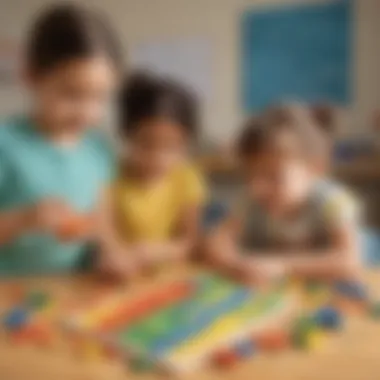Free Math Lessons for Kindergarten: A Complete Guide


Intro
Math education in kindergarten sets the foundation for a child’s future learning. By introducing basic concepts such as counting and number recognition, children begin to develop critical thinking skills early on. This comprehensive guide directs educators and parents to a spectrum of free resources for teaching math to kindergartners effectively. Whether through activities, quizzes, or fact-based articles, the emphasis is on engaging methods that promote understanding and enjoyment of math.
Creative Activities
Engaging children through creative activities is crucial for enhancing their understanding of math. From craft ideas to interactive games, there are various ways to piqué a child's interest in mathematics.
Craft Ideas
Here are some creative craft ideas that help instill fundamental math concepts while children express their creativity:
- Number Collage: Children can cut out numbers from magazines and glue them onto a paper, reinforcing number recognition.
- Shape Sorting Boxes: Create boxes marked with different shapes and let children sort cut-out paper shapes into the right box.
- Math Art Projects: Use colors to form groups, like creating a rainbow with specific numbers of each color.
Step-by-Step Guides
These craft ideas come with simple step-by-step guides to aid the process:
- Gather craft materials such as paints, paper, and safe scissors.
- Explain the math concept underlying each craft, such as shape recognition or counting.
- Allow participants ample time to create and discuss their projects.
Educational Value
Engaging in these activities offers several benefits. It helps develop fine motor skills, enhances creativity, improves problem-solving abilities, and reinforces math concepts in a tactile manner.
Fun Quizzes
Quizzes serve as a fun and effective method for consolidating learning. They can engage children by making math concepts accessible and enjoyable.
Quiz Topics
Some topics covered in the quizzes available on ElemFun include:
- Basic Addition and Subtraction
- Shapes and Colors
- Counting to 20
Question Types
The variety of question types used to engage children includes:
- Multiple choice questions
- True or False statements
- Fill-in-the-blank scenarios
Knowledge Reinforcement
These quizzes reinforce learning by providing instant feedback, allowing children to recognize areas of understanding and areas needing more focus. The enjoyment derived from quizzes promotes a positive attitude towards math learning.
Fact-Based Articles
Fact-based articles present invaluable knowledge in an accessible way, geared towards young learners. Children's understanding of math is amplified when presented in an engaging format.
Topics
These articles cover a diverse range of topics such as:
- Everyday Applications of Math
- Understanding Time and Money
- Introduction to Fractions
Engaging Content
The presentation style of these articles is crucial. The language used is straightforward, accompanied by visuals to enhance comprehension, ensuring that complex information is translated into basic, understandable ideas.
Prelude to Kindergarten Math Education
In the realm of early education, kindergarten math education holds significant importance. This stage lays the groundwork for more advanced concepts that children will encounter in their future studies. For young learners, mastering basic mathematics may seem like a daunting task, but it is essential for cognitive development and everyday functioning. Math skills acquired during kindergarten help to foster logical reasoning, problem-solving abilities, and critical thinking, which are paramount in today's fast-paced world.
Importance of Early Math Skills
The development of early math skills speaks directly to what children will achieve later in their educational journey. These foundational abilities do not just revolve around counting and simple arithmetic; they include recognizing patterns, understanding sequences, and engaging in spatial reasoning. When children grasp these early concepts, they build confidence in their mathematical capabilities. This ultimately encourages a positive attitude towards math, reducing anxiety and fostering a willingness to engage with more complex ideas in the future. Furthermore, children with strong math skills are generally better equipped to tackle challenges across various subjects, as mathematics is often termed the language of other disciplines.


Overview of Learning Objectives
Setting clear learning objectives is vital in guiding kindergarten math education. Educators must outline specific goals to achieve optimal learning outcomes for their students. Here are a few key objectives that are beneficial in a kindergarten setting:
- Number recognition: Children should be able to identify numbers 1 through 10, moving on to 20 progressively.
- Counting: Activities should encourage counting objects, both forwards and backwards.
- Basic operations: Introducing addition and subtraction using tangible materials helps solidify these ideas.
- Shape recognition: Identifying basic geometric shapes must be introduced at this stage to enhance spatial skills.
- Measurement concepts: Understanding length, weight, and volume, even on a very rudimentary level, introduces children to relevant real-world mathematics.
By establishing these learning objectives, both parents and educators can track the progress of child and ensure that each child is equipped with essential foundational math skills. Early math education must focus on cultivating curiosity and excitement about the subject, steering clear of pressures that can may inhibit interest.
Emphasizing a structured approach within a supportive learning environment is vital for successful kindergarten math education.
Types of Math Concepts for Kindergarten
Understanding foundational math concepts in kindergarten is crucial. These concepts build the groundwork for more complex mathematical understanding. Early introduction to a variety of math topics can enhance children's skills in problem-solving, logical thinking, and reasoning. Introducing math in a way that is simple and engaging gives young learners the confidence to explore further. A focus on various mathematical concepts means educators can provide balanced instruction, catering to different learning styles by integrating visual, auditory, and kinesthetic approaches.
Number Recognition and Counting
Number recognition is the first step in mathematical learning. It refers to the ability of children to identify and name numbers. This skill is vital as it leads to counting and understanding numerical values. Teaching through visual aids, such as number charts and counters, ensures that students can grasp number concepts with curiosity
- Counting should be made daily activity. When children take turns counting items in the classroom or while playing games, it reinforces counting skills. Children can practice these skills using activities such as:
- Counting objects: This can involve using toys or everyday items.
- Songs and rhymes: Engaging in songs like
Accessing Free Math Resources
Accessing quality resources is essential for teaching kindergarten math effectively. In today’s digital age, numerous free materials are available online. These resources cater to various learning styles, helping to keep young learners engaged. Educational tools, worksheets, and games can enhance a child's understanding of fundamental math concepts.
Online Platforms Offering Free Materials
Online platforms have become vital for educators and parents seeking free math education resources. Numerous websites host a variety of materials suitable for kindergarten math. Some notable platforms include:
- Khan Academy Kids - This platform provides interactive lessons aimed at young learners. The content covers critical areas such as counting, addition, and shape recognition, tailored for effective engagement.
- ABCmouse - Although it features paid subscriptions, this site offers a selection of free resources. Lessons focus on various subjects, including math, entrancing children to learn while having fun.
- Education.com - It contains extensive collections of worksheets and lesson plans that parents and educators can utilize without cost.
- PBS LearningMedia - Offers free videos and interactive lessons that incorporate math storytelling, making lessons more engaging.
These platforms don't only provide math content but also encompass strategies that motivate children in learning. With visual aids and interactive experiences, they are essential for developing early math skills.
Printable Worksheets and Activities
Printable worksheets are effective tools for reinforcing math concepts taught in a fun way. They allow children to practice in an environment they're comfortable with. Resources for printable materials include:
- Teachers Pay Teachers - This site sometimes offers free worksheets specifically designed for kindergarten-level math. These goods are created by educators searching to share and sell their materials.
- K5 Learning - It supplies carefully crafted worksheets that cover topics ranging from simple addition to understanding shapes.
- Scholastic - They offer themed activity sheets that often integrate a season or holiday, enhancing the fun factor of learning.
Worksheets provide repetiton, which solidifies understanding. They can be filled out individually or in collaboration. The act of seeing answers written down aids memory surety for young children.
Interactive Games and Apps
The growing library of interactive games and apps significantly enriches math learning experiences for kindergarteners. Utilizing game-based learning captures their attention effectively. Some notable free apps include:
- Endless Numbers - This app offers interactive play with number concepts. Children learn through puzzles, videos, and interactive tasks.
- Duck Duck Moose - Each game covers different aspects of math, such as counting and sequencing, meant for playful learning.
- Math Bingo - Engaging in familiar games in the app format helps children become comfortable with various tenets of mathematics.
Interactive games heighten engagement and promote friendly competitive settings. They allow for adaptive learning approaches where children can progress at individual pace.
Remember: Accessing free math resources effectively equals unlocking mathematical knowledge for kindergarteners, arming them for future academic success.
Teaching Strategies for Kindergarten Math
Teaching strategies are essential for creating an effective learning environment in kindergarten math. These strategies foster understanding and engagement, equipping young minds with foundational skills. Early math education should not only focus on knowledge acquisition but also on nurturing an appetite for learning. This section discusses varied pedagogical techniques tailored for young learners.
Hands-on Learning Techniques
Hands-on learning is vital in kindergarten math. Children are naturally curious, learning best through exploration. Incorporating manipulatives like blocks or counters helps to cement abstract concepts. For instance, using fingers to count encourages numeral understanding while reinforcing fine motor skills.
Activities could include:
- Sorting Objects: This builds categorization and early algebraic thinking.
- Shape Creation: Using play-dough or drawing shapes enhances shape recognition.
- Measurement Games: Allow students to measure items with standard or non-standard units.
Consider hands-on learning as a channel to promote problem-solving and critical thinking. It allows children to make tangible connections with math concepts, leading to deeper comprehension.
Incorporating Visual Aids


Visual aids play a significant role in kindergarten math teaching. Young learners benefit from seeing concepts represented visually. This could involve charts, diagrams, and illustrations that make complex ideas appear simpler. Visual elements can free language barriers, thus making it easier for children whose first language might not be English.
Some effective visual aids include:
- Number Lines: Assist in representing addition and subtraction.
- Flashcards: Useful for reinforcing number recognition and basic facts.
- Posters: Display common shapes and their properties within the classroom.
Teachers should integrate these aids in sessions regularly. By using them strategically alongside verbal explanation, educators aid children in forming mental images of what they learn.
Utilizing Storytelling for Conceptual Understanding
Storytelling can bridge conceptual gaps in kindergarten math. Children respond well to narratives, and embedding math within stories makes learning relatable. This approach fosters a love for math by connecting it with enjoyable experiences.
Incorporating math storytelling can involve:
- Problem-solving Stories: Create scenarios where characters face mathematical challenges.
- Math-themed Books: Utilize literature like
Creating a Structured Learning Environment
Creating a structured learning environment is crucial for effective math education in kindergarten. Such an environment helps to promote an atmosphere where children can comfortably explore mathematical concepts. A structured setup provides a reliable framework that aids concentration, organization, and clear expectations. Additionally, continuity in routine fosters security, thereby allowing children to focus more on learning and less on uncertainty.
A well-organized space encourages meaningful engagement with learning materials and concepts.
Establishing Routine and Consistency
Establishing routine and consistency can significantly enhance math learning in kindergarten. When children know what to expect each day, they can acclimate more easily to various educational activities. Using predictable structures for lessons, such as starting with a number recognition activity or ending with a shape-based game, creates a sense of familiarity. This allows students to spend less mental energy on uncertainties and more energy on engaging with the content.
In practical terms, set a consistent daily schedule and communicate it to the children. Engage them in discussions about the timeline, so they visually grasp what comes next in the math lessons. Consider using visual schedules with icons or images that represent activities. This method will support visual learning and provide another layer of comprehension.
Motivating Children Through Positive Reinforcement
Positive reinforcement plays a vital role in motivating young learners. Celebrating small achievements builds confidence and encourages students to pursue more challenging tasks. Frequent affirmations, in the form of praise or tangible rewards, can be powerful motivators. Even simple acknowledgments like a sticker or verbal praise such as “Great job counting those blocks!” fosters enthusiasm and interest in math.
In addition to immediate reinforcement, a reward system can be adopted over a period of time to guide students towards specific goals. Establish clear criteria for recognition. This way, children will understand what behaviors or achievements will earn them praise. Encouraging a supportive framework not only helps in motivating students but also fosters a positive attitude toward math itself.
Evaluating Progress in Math Skills
Evaluation plays a crucial role in math education, especially for kindergarten learners. Assessments help educators and parents track children's progress and ensure a solid mathematical foundation. By regularly evaluating progress in math skills, we can identify areas of strength or challenges, allowing timely support and intervention.
Gathering evidence of what students know and can do is essential to tailored instruction. This tracking not only focuses on academic achievement but also enhances the child's overall learning experience. It can create pathways for further growth, leading to improved confidence levels in math.
Assessing Understanding Through Observation
Observation is one of the simplest yet effective methods for assessing a child's understanding of math concepts. By attentively observing children during math activities, educators can gauge their enthusiasm and skill levels.
Observation should focus on several key elements:
- Engagement: Is the child participating in the tasks? Do they exhibit enjoyment?
- Problem Solving: How does the child approach challenges? Are they willing to try and solve problems independently?
- Peer Interaction: Witnessing how children work with their peers can demonstrate their communication skills and collaboration.
By taking notes on individual progress and discussing them, an educator or parent can evaluate how understanding develops.
Using Simple Assessments and Feedback
Simple assessments can complement observational methods effectively. Conventional assessments like quizzes or games can provide clear insights into a child's understanding and retention of math concepts.
Consider the following strategies while using assessments:
- Frequent Quizzes: Short, informal quizzes help gauge understanding without adding pressure. This can include oral questions or written answers on worksheets.
- Interactive Games: Turning assessments into games promotes motivation. Tools like downloadable math games or puzzles engage children while assessing their skills at the same time.
- Feedback: Providing simple and immediate feedback is essential. It helps children recognize their achievements and understand areas needing improvement. This feedback channels into positive reinforcement, encouraging continual learning.
Community Resources for Math Learning
Access to diverse community resources plays a crucial role in enhancing early math education. Establishing connections between schools, families, and local institutions widens the learning opportunities available to kindergarten students. When teachers and parents collaborate with community resources, it creates a enriched environment for promoting math understanding.
Community resources can include local libraries and various programs that offer unique learning experiences. These resources provide practical experiences beyond what can be taught in traditional classroom settings. Engaging children in such supportive environments allows them to explore math in various ways, fostering a deeper understanding of concepts.
Libraries and Local Programs
Libraries serve as a fundamental part of community education. They often host programs specifically aimed at young children, where math can be introduced in an accessible way. Many libraries offer free story time events focused on books that incorporate counting, patterns, and shapes. These activities can serve as a motivating first step into math education for children.


Benefits of library programs:
- Free Access: All resources are typically available at no cost to parents.
- Variety of Learning Materials: Many libraries have collections of math-based storybooks, puzzles, and educational games.
- Qualified Staff: Staff members can guide children and parents to appropriate materials that match their learning needs.
Moreover, local programs, such as community centers or nonprofit organizations, often provide specialized workshops and activities related to math.
- Interactive Learning: Programs may include crafts or a hands-on activities that necessitate counting or measuring, encouraging participation and application.
- Collaborative Learning Opportunities: Children benefit from engaging with peers, enhancing their social learning experiences along with mathematical understanding.
Parent and Teacher Workshops
Workshops designed for parents and teachers serve another essential purpose in supporting math education in kindergarten settings. These sessions aim to educate adults on effective teaching methods and strategies that can be used at home and in classrooms. Such workshops create a shared understanding of educational frameworks and also align methods employed by parents and educators alike.
Considerations for attending workshops include:
- Resourcefulness: Parents can gain access to valuable teaching resources, enabling them to offer consistent support at home.
- Networking Opportunities: Workshops also afford parents valuable connections with other families and educators, building a community of support.
- Skill Development for Educators: Teachers might learn innovative ways to present mathematical concepts, ensuring that lessons remain engaging and age-appropriate.
Engaging in these workshops has potential long-term advantages for children's learning pathways.
Understanding and utilizing community resources can lead to a comprehensive approach in shaping a child's perception of math; an ongoing relationship that encourages curiosity and exploration right from the start.
Building a Foundation for Future Math Learning
Building a strong foundation for future math learning is crucial for kindergarten students. The early years of education shape a child’s perspective on math and influence their willingness to engage with the subject as they progress. A solid foundation allows them to develop essential skills necessary for complex concepts in later grades. Also, starting with the appropriate level of competency eases the transition to first grade, reduces anxiety regarding new challenges, and fosters confidence in their ability to handle math assignments. Encouraging the right practices early on can make a remarkable impact on their overall academic success.
Transitioning to First Grade Math Skills
Transitioning to first grade brings more demanding math challenges. It is important for kindergarten educators and parents to emphasize the more advanced concepts children will encounter. Core areas that first-graders focus on include:
- Addition and subtraction operations: Continuing from basic sums under 10 to more complex interactions.
- Number lines: Understanding sequences and distances can provide clarity.
- Word problems: Nurturing critical-thinking skills by helping students understand how to apply math in real-life scenarios.
Unsurprisingly, this transition can be overwhelming. Therefore, an incremental approach to skill building is recommended. Ensure children master basic skills before graduates dive into multi-step problems. This minimizes frustration and promotes a supportive emotional atmosphere for learning.
Fostering a Love for Math
Cultivating a love for math at an early stage is vital. When children enjoy learning math, they engage more deeply and willingly immerse themselves in necessary practices. To nurture this affection for the subject:
- Incorporate play into lessons: Use games and hands-on activities to make the subject feel enjoyable.
- Connect math to their interests: Using familiar contexts helps children see the relevance of math, as doing so creates empathetic learning. Forinstance, calculate total price tags with students if they are interested in shopping.
- Celebrate their achievements: Acknowledgement motivates them to try again or take on more challenges. Whether through displays of their work or verbal praise, showing recognition stems encouragement.
“When children understand math as a useful tool, they start to view learning it not just as an academic requirement but as an exciting journey.”
By nurturing a productive environment enriched with engaging content, kindergarteners can develop a genuine fondness for math while establishing essential progress on future skills. This critical combination lays a robust groundwork for first grade and beyond, minimizing fears often associated with upcoming academic trials.
Finale
In any discipline, the conclusion plays an essential role in summarizing the topics discussed throughout the narrative. For early math education, the conclusion serves as a moment to reflect on the materials provided and the strategies that were discussed. This section can highlight the significance of building foundational math skills in young students, and it empowers parents and educators to keep nurturing a positive math environment.
When teaching math to kindergartners, one must focus on the importance of engaging resources, effective methods, and maintaining enthusiasm. The lessons explored in this guide are more than just numbers and operations; they shape a child's confidence and problem-solving endurance. All these aspects prepare a student for advanced math concepts later.
“Fostering early math development enables a child’s cognitive growth and inquiry.”
Kid-friendly resources, practical teaching strategies, and community involvement create a learner-centered approach. Here are the key aspects:
- Flexible resources specifically designed for this young age.
- Diverse teaching strategies, ensuring adaptability to different learning styles.
- Incorporation of feedback and assessments that do not overwhelm but support the youthful learner.
- Community resources that promote continuous learning outside formal settings.
The conclusion integrates all these points by presenting a compelling picture of the solid foundation one can create, nurturing engaged learners. Thus, giving approriate guidance to encourage good math skills appears crucial for educators and parents alike.
Recap of Key Points
In this comprehensive guide, we established several important highlights:
- The value of early math skills and how essential they are for cognitive development.
- Various concepts emphasized in kindergarten math, such as number recognition, basic operations, and spatial awareness.
- The availability of rich resources, including online platforms and printable materials that enhance one’s teaching portfolio.
- Vital teaching strategies that support active learning among kindergarteners.
- Structured environments foster a sense of routine and confidence as the child learns effectively.
- The need for regular assessments, ensuring progress is tracked without adding undue stress.
- Community tools, such as libraries and workshops, which offer extra support beyond the classroom.
These key points closely connect to the broader notions required for nurturing young minds as they embark on math education.
Encouragement for Ongoing Learning
The journey of learning math does not conclude in kindergarten. It serves as an initial stepping stone toward future educational experiences. As parents and educators, continued support in math extends beyond to the next level towards even more intricate concepts in going forward years.
Encourage children to explore numbers and problems in a lighthearted manner. Use math while cooking, shopping, or during outings. The aim is to integrate meaningful experiences, teaching them that math surrounds them daily.
Remaining informed about new ways to teach kindergarten math can quite empower those focused on fostering ongoing learning. Exploring resources on the Wikipedia and Britannica can offer fresh insights about math teaching techniques.
This strategy builds confidence in their abilities and inspires a positive attitude - not just about math, but learning in general. The lessons introduced in this article are fundamental; instilling a sense of wonder for learning should become a mission. Ultimately, creating inquisitive thinkers leads them into remarkable future paths.







